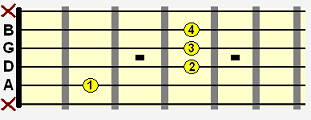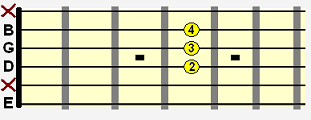When it’s just you playing with your guitar, without the convenient aid of a bassist, you should experiment with moving the chord bass notes around yourself.
By keeping a chord shape static as you apply a progressive bass pattern around it, using the lowest 2 strings of your guitar, you can create a defined movement with minimal finger changes…

B major movable chord

B major with E bass note (B/E)

A flat minor 7 shell chord (Abm7)

G major added 6 open chord (Gadd6)
So the B major chord becomes what we call a “slash chord” with an E bass note. As the note E is part of the B major key, it’s compatible. It was then just a case of finding a suitable next movement for that E string bass note, again, ensuring the new note is compatible with the static B major triad.
The vibrant open G chord provided a slightly unpredictable collapse down from the unstable Abm chord. Personally, I love the sound of moving down a semitone, from minor to major. If that major landing chord happens to resolve naturally back to the tonic (or even a new tonic), then it gives it a kind of logical after-thought. In this case, I felt the G major chord could resolve nicely back to the B major tonic, even though it lies outside of the traditional diatonic framework.
So do try working those bass lines around static chord shapes and see if you can weave them into your progressions, as opposed to crowbarring! Your mind should be a pool of ideas, free of closed intentions. Let your fine balance of intuition and exploration craft the chord progression.